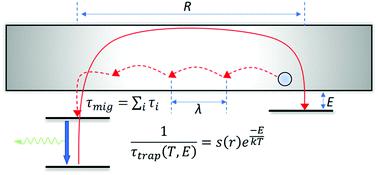当前位置:
X-MOL 学术
›
Phys. Chem. Chem. Phys.
›
论文详情
Our official English website, www.x-mol.net, welcomes your feedback! (Note: you will need to create a separate account there.)
Study of persistent luminescence and thermoluminescence in SrSi2N2O2:Eu2+,M3+ (M = Ce, Dy, and Nd).
Physical Chemistry Chemical Physics ( IF 3.3 ) Pub Date : 2020-07-06 , DOI: 10.1039/d0cp01739f Natalia Majewska 1 , Tadeusz Leśniewski , Sebastian Mahlik , Marek Grinberg , Alicja Chruścińska , Daniel Michalik , Małgorzata Sopicka-Lizer
Physical Chemistry Chemical Physics ( IF 3.3 ) Pub Date : 2020-07-06 , DOI: 10.1039/d0cp01739f Natalia Majewska 1 , Tadeusz Leśniewski , Sebastian Mahlik , Marek Grinberg , Alicja Chruścińska , Daniel Michalik , Małgorzata Sopicka-Lizer
Affiliation

|
The process of persistent luminescence or glow-in-the-dark, the delayed emission of light of irradiated substances, has long fascinated researchers, who have made efforts to explain the underlying physical phenomenon as well as put it to practical use. However, persistent luminescence is an elusive and difficult process, both in terms of controlling or altering its properties, as well as providing a quantitative description. In this paper, we used SrSi2N2O2:Eu2+ as a model persistent phosphor, characterized by the broad distribution of structural defects and exhibiting long-lasting Eu2+ luminescence that is visible for a few minutes after switching off UV light. We investigated the persistent luminescence process by two complementary methods, namely, thermoluminescence and temperature-dependent persistent luminescence decay measurements. Analysis of experimental data allowed us to determine the depth distribution of traps, and allowed us to distinguish two different mechanisms by which the emission is delayed. The first, the temperature-dependent mechanism, is related to trap activation, while the second, temperature-independent mechanism is related to carrier migration. Finally, we employed the strategy of the co-doping of the phosphor SrSi2N2O2:Eu2+,M3+ (M = Ce, Nd, Dy) to modify the persistent luminescence properties.
中文翻译:

研究SrSi2N2O2:Eu2 +,M3 +(M = Ce,Dy和Nd)中的持续发光和热致发光。
持续发光或暗中发光的过程,即被辐射物质的光延迟发射,一直吸引着研究人员,他们努力解释了潜在的物理现象并将其付诸实践。然而,就控制或改变其性质以及提供定量描述而言,持续发光是一个难以捉摸且困难的过程。在本文中,我们将SrSi 2 N 2 O 2:Eu 2+用作模型持久性磷光体,其特征在于结构缺陷的分布广泛,并具有持久的Eu 2+关闭紫外线后几分钟内可见的发光。我们通过两种互补的方法研究了持久发光过程,即热发光和温度相关的持久发光衰减测量。对实验数据的分析使我们能够确定阱的深度分布,并使我们能够区分出延迟发射的两种不同机制。第一个与温度有关的机制与陷阱激活有关,而第二个与温度无关的机制与载流子迁移有关。最后,我们采用了共掺杂磷光体SrSi 2 N 2 O 2:Eu 2 +,M 3+的策略。 (M = Ce,Nd,Dy)来修改持久发光特性。
更新日期:2020-08-05
中文翻译:

研究SrSi2N2O2:Eu2 +,M3 +(M = Ce,Dy和Nd)中的持续发光和热致发光。
持续发光或暗中发光的过程,即被辐射物质的光延迟发射,一直吸引着研究人员,他们努力解释了潜在的物理现象并将其付诸实践。然而,就控制或改变其性质以及提供定量描述而言,持续发光是一个难以捉摸且困难的过程。在本文中,我们将SrSi 2 N 2 O 2:Eu 2+用作模型持久性磷光体,其特征在于结构缺陷的分布广泛,并具有持久的Eu 2+关闭紫外线后几分钟内可见的发光。我们通过两种互补的方法研究了持久发光过程,即热发光和温度相关的持久发光衰减测量。对实验数据的分析使我们能够确定阱的深度分布,并使我们能够区分出延迟发射的两种不同机制。第一个与温度有关的机制与陷阱激活有关,而第二个与温度无关的机制与载流子迁移有关。最后,我们采用了共掺杂磷光体SrSi 2 N 2 O 2:Eu 2 +,M 3+的策略。 (M = Ce,Nd,Dy)来修改持久发光特性。


























 京公网安备 11010802027423号
京公网安备 11010802027423号